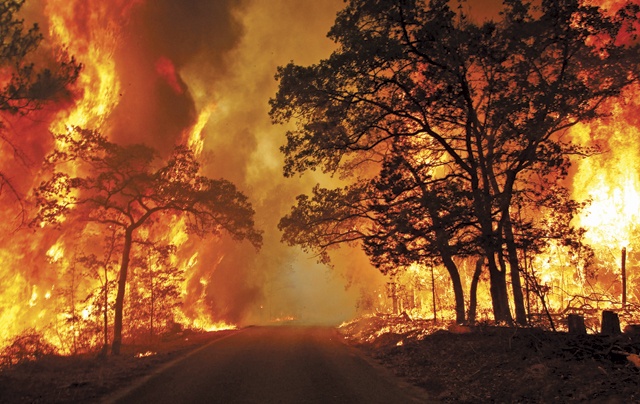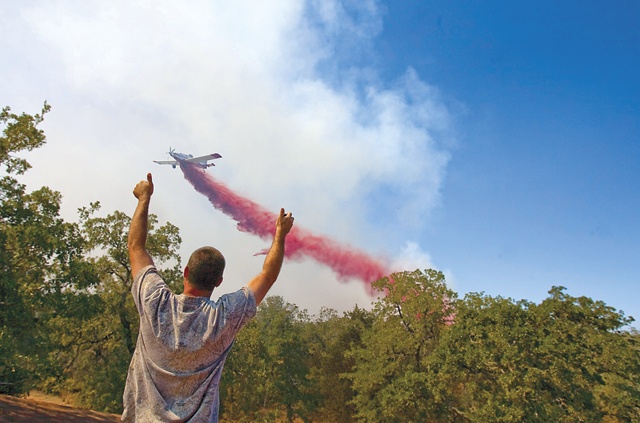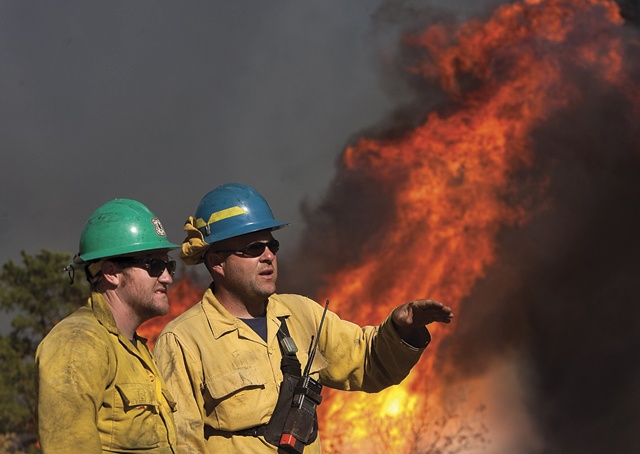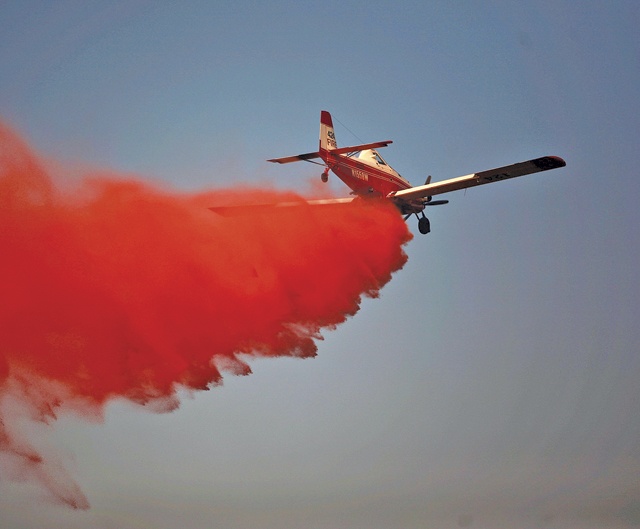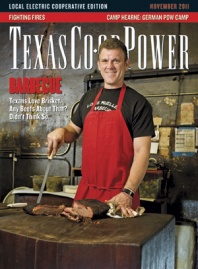Editor’s note: In wildfires across the state, volunteer ground crews have been the backbone of firefighting forces. The courage of those volunteer firefighters will be recognized as part of a Texas Co-op Power story coming in January.
On August 30, aerial firefighter Marc Mullis abruptly ends a telephone interview mid-sentence. “I’m getting a signal,” he says, referring to a dispatch on his cellphone. “We just got a fire. I gotta go.”
That night, after dropping fire retardant around wildfires near Junction, a weary Mullis sends this hastily typed e-mail from the Gillespie County Airport’s Hangar Hotel: “Sorry I had to cut you off but the fire turned into seven fires and I got very busy saw several homes burn down this afternoon but I know I saved one.”
Mullis is not a superhero. He’s a professional, full-time firefighter who makes pinpoint-accurate fire retardant drops—and who developed some of his skills years ago as an agricultural aviation pilot. His job is to help contain fires and support ground crews in the trenches. He can’t perform magic, but he can sure do a lot of good.
And just like the members of a support system in place across Texas, he’ll never stop scrapping—even though since last fall, it’s been a grossly unfair fight: More than 3,000 ground and aerial firefighters, many coming to Texas’ rescue from around the nation, have been desperately outnumbered by blazes in the worst wildfire season in state history.
In this tinderbox called Texas, firefighters have responded to almost 24,000 fires burning close to 4 million acres and destroying almost 2,800 homes since mid-November 2010.
One year later, Texas is still in flames. Yes, it’s fall now. Temperatures, blessedly, have finally dropped from record-setting triple-digit heat. But as firefighters continue to battle the horrific blazes sweeping our drought-stricken state, they grimly point to a frightening fact: With a lack of rain, there remains plenty of fuel—i.e., dry grass and trees—for fires to feed upon.
There’s no telling when this nightmare will end.
Aerial firefighter David Guetersloh (pronounced GOO-ter-sloh), who owns an aerial application business in Plains, west of Lubbock near the New Mexico border, also learned to fly in ag aviation airplanes. When asked if he’s ever seen such dry conditions, the 58-year-old replied, “Never, ever, and I don’t see any change coming. I’ve flown all across this country, and it’s never looked like this.”
What’s really scary is that any number of potential culprits—barbecue pits, cigarettes flicked out of car windows into ditches, overheated wheel bearings on fast-moving vehicles, welding, dry lightning—can start wildfires.
“We’re so hot and dry, a little wind and a spark, and here we go,” Guetersloh says.
‘I’ve Been in Tears’
The 55-year-old Mullis, who soloed at age 16, has 34,000-plus hours of flight time and thousands of missions flown as an aerial firefighter. He doesn’t flinch at the sight of flames beneath his wings. In April, he flew missions for more than a week on the state’s largest-ever wildfire: the Rock House Fire that scorched more than 314,000 acres in far West Texas.
But nothing prepared him emotionally for this year of hell. “I’ve been in tears flying over, watching houses burn,” Mullis said in early September. Cruelly, during Labor Day weekend, the high winds of a tropical storm produced new wildfires in Central Texas—most notably the 34,000-acre-plus Bastrop County Complex fire—but scant moisture.
Yet the longer the fires burn, the brighter the everyday heroes shine: the boots-on-the-ground volunteer, municipal and Texas Forest Service firefighters who build containment lines with bulldozers, shovels and axes. The engine crews who work the front lines, spraying water and fire-retardant foam. The aerial firefighters who drop fire retardant and water from helicopters and airplanes, including one of the biggest birds of all: a DC-10 air tanker, a jetliner, requested by the Texas Forest Service and used to drop retardant on blazes in the Huntsville area.
And waiting in the wings is an equally important, yet less visible group of firefighters: single-engine air tanker pilots like Mullis and Guetersloh, whose decision-making and low-altitude flying skills honed during ag aviation careers make them ideally suited for fighting fires.
Please understand, these pilots say: They’re proud of their ag aviation backgrounds. All those years spent flying low over crops, dodging obstacles, navigating sudden gusts of wind and taking off with heavy loads prepared them for firefighting careers. Yet some people, they say, mistakenly think they’re ag pilots pulled off field duty to spray a little water on fires.
Some ag pilots around the state are on standby to help fight local wildfires—their efforts are invaluable. But the distinction is this: Mullis, who ran his family’s southeast Arkansas aerial application business for 28 years, and his comrades are professional aerial firefighters. And so are their planes: AT-802s made by Olney-based Air Tractor, the world’s largest maker of ag aircraft. These planes—single-engine air tankers called SEATs—aren’t designed to treat crops. They’re built exclusively to fight fires.
Much more nimble than larger aircraft, with hoppers holding up to 8,000 pounds of fire retardant, SEATs pack an effective punch as they swoop in for the initial attack. Flying in formation as low as 60 feet above ground, each pilot, in succession, peels off to drop loads of highly visible, red-dyed fire retardant in front of flames. The pilots build a long buffer line that slows and cools the fire, buying time for the firefighters below to dig in on the perimeter.
When ground crews see the red and white planes with the word FIRE painted on the tails and red plumes of fire retardant dropping from the aircrafts’ bellies, they know the cavalry has arrived.
Better to Repaint Than Rebuild
Of the 15 SEATs flying in the state, six are owned by Texas-based aerial application operations: M&M Air Service of Beaumont has four, and GB Aerial Applications of Plains, owned by Guetersloh, has the other two.
M&M Air Service, which also does substantial ag business, employs 10 aerial firefighters, including Mullis, the flight training supervisor. At GB Aerial Applications, which focuses primarily on fighting wildfires, Guetersloh is one of six aerial firefighters.
Both operations have used Fredericksburg as a temporary base this year, and M&M Air Service’s firefighters have been stationed in Fort Stockton to be near far West Texas blazes. But home, which means a runway and mobile fuel and retardant trucks, is wherever the pilots land at day’s end, and they’re often diverted in flight. In extreme fire situations, when there’s no time to fly back to base, the SEATs are equipped to land on paved or dirt roads for reloading.
SEAT pilots, like all aerial firefighters, operate with military precision. They do not take off until they have received an aircraft dispatch form from Texas Forest Service headquarters in Merkel, near Abilene, containing all pertinent information about a fire. In flight at the scene, they obey orders from an air tactical group supervisor—called the air attack—who soars about 1,000 feet above them.
The air attack monitors fire and aerial activity while his pilot keeps their twin-engine plane—called the air attack platform—circling like a hawk above the blaze.
Just like unpredictable winds, SEAT pilots must be ready to quickly shift direction. On August 30, with aerial firefighters tackling hot spots across the region, Mullis was directed to take off alone for the Junction area. Air attack orders changed as he neared his target: Instead of dropping retardant in front of a fire, he was instructed to immediately head for a house that was in flames.
“I dropped in their front door,” Mullis sums up. And he saved the house.
There’s nothing flippant about Mullis’ remark. If there’s a chance of preventing a home’s destruction, SEAT pilots don’t hesitate: They’re dropping in. Such was the case at the first Possum Kingdom fire this year in April (unthinkably, the area went up in flames again in August). Guetersloh and other aerial firefighters dropped retardant on houses already in flames to prevent nearby houses from catching fire.
Many people ask: Will the red retardant permanently stain structures? The manufacturer’s answer is that in most cases, it should wash off with water or scrubbing or power washing (see the Fire Retardant sidebar).
It sure beats the alternative, Guetersloh says: “It’s easier to repaint it than to rebuild it.”
‘Get Your Britches On’
SEAT pilots mostly operate in anonymity, darting in and out of fire zones. But sometimes, they receive unexpected recognition. One night, Mullis, fellow M&M Air Service firefighter Bill Rose, truck driver Ted Freeman and SEAT Manager Don Moline were eating dinner at a Fredericksburg restaurant. A waitress, seeing the logos on their caps and shirts, asked if they were firefighters.
Yes, the men said. Next thing they knew, appreciative strangers from out of state were paying for the group’s meal.
The firefighters recalled the event on Friday morning, September 2, at Fredericksburg’s Hangar Hotel where they’d been staying the past several days. Guetersloh wasn’t at the restaurant that night, but he’s had similar experiences. “Things like that,” he says, slowly placing his right hand over his heart, “they don’t go away.”
The conversation fades away, and the men go back to arguably the hardest part of their jobs: waiting for the call to fly. It’s after lunch, and they’re pacing, talking on their cellphones and monitoring wildfire activity on a laptop computer.
Suddenly, Air Attack Commander Dick Stiliha of California bursts into the large room. “Yo, you guys might want to get your britches on,” he says, referring to their flame-retardant coveralls. “We got one.”
The firefighters go into seamless motion, pulling on coveralls and checking their belongings. They might not be coming back to this airport—hence the small travel bags and the larger ones they keep onboard packed with a week’s worth of clothes. “This is an in-between bag,” Rose says of his carry-on. “You try to stay organized as much as you can.”
Their birds wait outside, and Mullis’ T-shirt bears his tail tanker number, T-409, with this sentiment: “SHE’S SO FINE SHE’S ALL MINE.”
Mullis slips into his orange coveralls, and within five minutes of receiving the takeoff order, he and three other SEAT pilots—Rose, Guetersloh and one of Guetersloh’s pilots, Mike Hanneman—take off for a wildfire east of Johnson City, about 35 miles away.
The smoke is visible from town, and over a subdivision flanked by ranch land, the SEATs go to work: Mullis in T-409, Guetersloh in T-828, Rose in T-441 and Hanneman in T-871. As Stiliha and his pilot, Fred Stone of Missouri, circle overhead in a white and blue Aero Commander, the SEAT pilots lay down the retardant line, each making four trips back to Fredericksburg for reloading.
About 1 1/2 miles away, two donkeys and a few cattle rest in the shade under a live oak tree, oblivious to the danger at hand. As is typical, there’s little fanfare afterward over the firefighters’ efforts. “Usually, we’re the only ones who see it,” Mullis says. “But we know.”
Mullis continues: “We did an excellent job. We definitely saved some houses. One house was just starting to burn. The house is now red.”
——————–
Camille Wheeler, associate editor
Note: Wildfires referenced in this story have affected the service territories of Bluebonnet, Central Texas, Fort Belknap, Pedernales and United Cooperative Services electric cooperatives.
